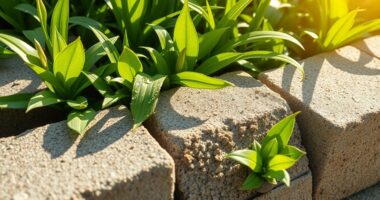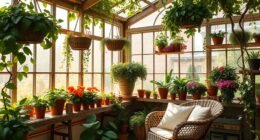To maximize your small urban space with a greenhouse, focus on creating a controlled environment that extends your growing season and boosts productivity. Use vertical gardening, compact composting like worm bins, and water-saving methods such as drip irrigation and rain catchment. Integrate these sustainable practices to make the most of your limited area and enjoy fresh produce year-round. If you keep going, you’ll discover even more ways to turn your space into a thriving homestead.
Key Takeaways
- Use compact greenhouse designs to extend growing seasons and maximize limited space efficiently.
- Incorporate vertical gardening and tiered shelving to increase plant capacity vertically.
- Implement small-scale composting methods like worm bins to enrich soil sustainably indoors.
- Employ water-saving techniques such as drip irrigation and rain catchment to conserve resources.
- Integrate diverse plant types and continuous cropping for year-round productivity in tight spaces.

Urban homesteading has become a practical way to grow fresh food and reduce reliance on stores, especially when space is limited. When you’re working within a small area, maximizing every inch is essential, and a greenhouse can be your best tool for doing so. Not only does it extend your growing season, but it also creates a controlled environment where plants thrive. To make the most of your greenhouse, you need to incorporate smart practices like effective composting techniques and sustainable water use. These strategies ensure you’re growing food responsibly while making the most of limited resources.
Start with composting techniques that fit small spaces. Instead of traditional piles, consider vermicomposting—using worms to break down organic waste quickly and efficiently. Worm bins are compact and can be tucked into a corner of your greenhouse or even indoors. They produce nutrient-rich compost that boosts plant growth without the need for synthetic fertilizers. Another option is bin composting, which involves small, contained units that can be easily managed and turned regularly. Using compost in your greenhouse reduces waste, enriches your soil, and minimizes the need for purchasing external fertilizers, aligning with sustainable practices. Plus, composting helps maintain healthy soil structure, crucial for container gardening or raised beds often used in small spaces.
Use compact vermicomposting or bin systems to enrich soil sustainably in small spaces.
Sustainable water use is equally important when working within limited space. Water conservation isn’t just eco-friendly; it’s practical. Install rain barrels or other catchment systems to collect rainwater, reducing your dependence on municipal water sources. You can also set up drip irrigation or soaker hoses to deliver water directly to your plants’ roots, minimizing waste and evaporation. Using moisture sensors can help you determine when watering is truly needed, preventing overwatering and promoting healthy plant growth. Collecting greywater from your household—like sink or laundry water—can also supplement your water supply, provided you follow safety guidelines. These practices help you use water efficiently, lowering your utility bills and conserving a crucial resource.
In your small urban space, combining effective composting techniques with sustainable water use creates a sustainable, productive environment. It allows you to grow a variety of vegetables, herbs, and flowers without overtaxing your limited resources. Every bit of effort you put into managing compost and water smartly translates into healthier plants and a more self-sufficient homestead. As you refine these practices, you’ll find that your greenhouse becomes not only a hub for fresh produce but also a model of sustainable urban living, proving that even limited space can support a thriving, responsible garden. Incorporating efficient resource management ensures your small space yields abundant results while maintaining ecological balance.
Frequently Asked Questions
How Do I Prevent Pests Inside My Greenhouse?
To prevent pests inside your greenhouse, you should implement effective pest control methods like introducing beneficial insects and manually removing pests. Use natural repellents such as neem oil or garlic spray to deter unwanted bugs. Keep your space clean, remove plant debris, and guarantee proper airflow. Regular inspections help catch issues early, and rotating crops prevents pest buildup, keeping your greenhouse healthy and pest-free.
What Are the Best Plants for Small Greenhouse Spaces?
You should choose compact plants like herbs, lettuce, or cherry tomatoes for small greenhouses. Use vertical stacking to maximize space, growing taller plants upward to free room below. Incorporate companion planting to boost growth and reduce pests naturally. This strategy helps you make the most of limited space while promoting healthy plants. Focus on versatile, space-efficient varieties that thrive in enclosed, small environments for the best results.
How Can I Optimize Sunlight in Limited Space?
To optimize sunlight in limited space, position your greenhouse where it gets maximum sun exposure, ideally south-facing. Use reflective surfaces like white walls or mirrors to bounce light into shaded areas. Incorporate composting techniques to enrich your soil, promoting healthy plant growth. Practice crop rotation to prevent soil depletion, ensuring your plants thrive in the available light. Regularly prune and space plants to maximize sunlight absorption and airflow.
What Are Cost-Effective Greenhouse Heating Options?
Your greenhouse can become a cozy oasis with cost-effective heating options. Solar heating is your best bet—installing simple solar panels or passive solar designs can drastically cut costs. Combine this with insulation methods like bubble wrap or horticultural fleece to trap heat. These solutions are budget-friendly and efficient, making your small space warm and thriving without breaking the bank. Your plants will flourish in a greenhouse that feels like a tropical paradise!
How Do I Maintain Humidity Levels Effectively?
To maintain humidity levels effectively, focus on humidity control and ventilation strategies. You should regularly monitor humidity with a hygrometer, then adjust ventilation to prevent excess moisture that can cause mold. Use fans or vents to promote air circulation, and consider adding a humidifier during dry periods. Proper airflow helps balance humidity, ensuring your plants thrive without risking disease. Consistent adjustments keep your greenhouse environment stable and healthy.
Conclusion
Think of your small space as a tiny seed with endless potential. Just like a greenhouse transforms limited land into a lush oasis, you can turn your urban patch into a thriving haven. I once watched a neighbor grow a vibrant tomato garden on a tiny balcony, proving that with the right tools and mindset, even the smallest spaces can yield big results. Your urban homestead is a seed—you just need to nurture it to see it flourish.








